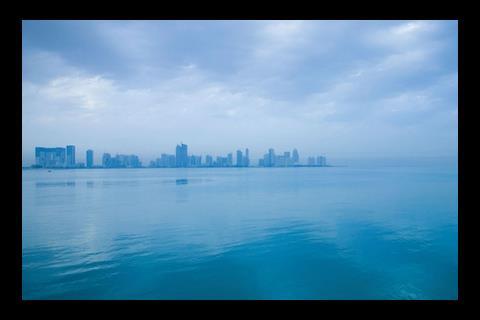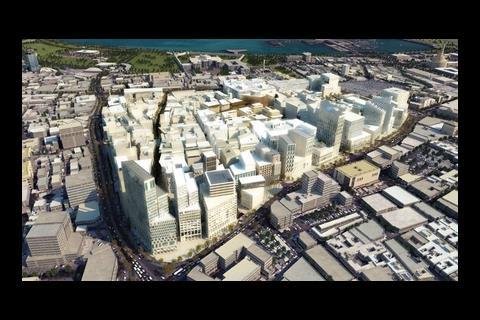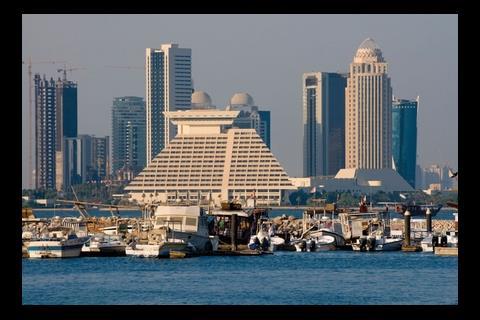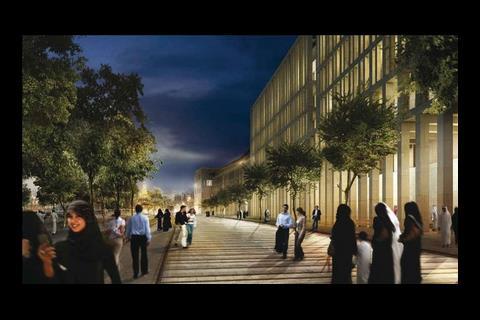Qatar is just about the richest country on earth, and it’s looking to completely rebuild itself over the next 10 years or so. Roxane McMeeken went there and found a land where the work is plentiful, but, shall we say, not without its difficulties …
‘Doing business here is like picking low-hanging fruit, but it’s prickly and poisonous fruit” – that’s how one consultant describes working in Qatar. It’s not a bad description. There’s plenty of work here but it’s not that easy to win or to carry out. Brits working here compare it to the UK in the eighties: the client rules supreme, contractors build, architects design and QSs are just above labradors in the project hierarchy. “It’s traditional with a capital T,” says the consultant.
All of which raises the question of whether the work is worth winning and doing. The answer is probably yes. First, there is the sheer volume of work on offer. Qatar was the world’s fastest growing economy in 2009 and it has just embarked on an immense building programme that encompasses everything from schools and hospitals to a giant bridge connecting it to the island state of Bahrain. Its construction industry grew 17% last year and is set for similar growth in 2010. The UK’s construction industry contracted for the 22nd consecutive month in December.
Second, the work is high quality. Projects such as the £3.5bn Heart of Doha scheme show the kind of sensitivity and planning that others in the region often lack (see box).
Then there’s the small matter of the global downturn, depressing the vast majority of other construction markets. Factor all this in and Qatar looks like an excellent place to be.
Why Qatar isn’t Dubai
A quick drive around Doha, Qatar’s capital, main seaport and home to more than 80% of its population, gives you an idea of what’s on offer. Over in West Bay, on the northern outskirts of the city, a small forest of tall buildings is arranged around a marina, including the brutally angled Zig Zag towers. The effect is of a mini Dubai, but it isn’t typical of the rest of the city. Doha is mostly made up of dilapidated low-rise buildings interspersed with the occasional five-star hotel. It is crying out for regeneration. And that’s just what’s coming.
A huge construction programme is beginning, and just about everything is going to be refurbished.
The reason that this boom is possible right now is that Qatar is ridiculously rich. Unlike Dubai, which borrowed to build, then used what was built, or even under construction, to borrow more, Qatar’s wealth is not based on its property market. Rather, it is being funded by the world’s third largest reserves of natural gas and the fourth largest reserves of oil in the Gulf Corporation Council (enough for 37 years production at the present level). These resources mean Qataris have an average income of £65,000, which is the second largest in world after Liechtenstein. One consultant says: “They’re like lottery winners – they have a pile of cash on their hands and they’re not sure what to spend it on, or who they can trust.”
This wariness is at the opposite emotional pole to Dubai. That emirate tried to create a mood of reckless excitement because while it was growing, that growth was self-supporting: for example the sheer volume of construction work created a market for the completed facilities. Kevin Sims, head of Davis Langdon’s Middle East operation, says: “Dubai stopped when construction stopped because it depended on construction folk living there and needing shops, doctors, schools and so on. As soon as they started leaving, everything died.

Where the money is going
The reason the boom is necessary is that the population of Qatar has just about doubled in size over the past few years: in 2004 it was 750,000; it’s now 1.4 million. To provide for these people, Qatar is planning to build seven cities, each of which can house 200,000 residents. About $42bn (£26bn) worth of projects are planned in the commercial, residential, hospitality and retail sectors, according to research firm Proleads. Another consultant, Smith Travel Research, reckons that there are 5,408 hotel rooms in the pipeline. The country also plans to spend $82.5bn on 191 civil engineering projects: that’s the equivalent of five Crossrails. These include the creation of a $25bn metro and light rail network in Doha. Germany’s Deutsche Bahn will break ground on that job this month; it is due to complete it in 2026.
Qatar is also beginning a massive school building programme. Although the government has not given details of its spending plans, it is putting education at the heart of its reconstruction efforts. The Supreme Education Council’s flagship project is the 1,000ha Education City, on the western edge of Doha, which is being developed by a state-linked client called the Qatar Foundation. It will include six universities, aiming to attract international students.
Sport is high on Qatar’s agenda, too. Two tennis tournaments, the ExxonMobil Open and the Sony Ericsson championship, have established themselves in Doha, and Qatar is also bidding to host the 2022 World Cup.
But Qatar is not without weaknesses. For one, the construction pipeline is prone to delays. The Public Works Authority (Ashghal) said in November that 32% of infrastructure schemes were delayed. It took some of the blame for this, citing design changes and retendering to take advantage of lower prices, but also blamed contractor insolvencies and downsizing caused by the global downturn.
A lack of co-ordinated planning is hitting other projects, too. For example, Qatar is aiming to be a regional financial hub, but the tower that was to have been the centrepiece of the new financial district has been put on hold. The reason is that if it were built, it would be situated under a flight path. Construction will now have to wait at least two years while Doha moves its airport.
Qatar’s property market is as vulnerable as any other to falling demand. Last year, office and residential prices fell by between 20 and 40% compared with 2008, according to consultant MarketResearch.com. House prices at the Pearl, a landmark development on an island to the north of Doha, dropped an average of 35%, indicating lack of foreign interest. House prices are expected to fall a further 15% in 2010 as about 10,000 homes hit the market. Office rents are unlikely to rise until the end of 2010. Property group DTZ says high levels of supply coming to the market and dampened demand owing to the global financial crisis would keep pressure down on rental rates.
Projects are being reshaped to reflect these market conditions. Al-Waab City, for example, a $3.2bn community under construction, has switched from selling residential properties to leasing them. And phased construction is the order of the day, too.
Although these trends are reducing flow rates in the construction pipeline, they are shoring up Doha for the longer term. Mark Groundsell, WSP’s technical director for the Middle East, says: “Qatar is on much more sustainable ground than Dubai. The brakes are on, which is a positive thing because it means you won’t get the overheating here that was inevitable in Dubai.”

What do they want from us?
Even with the brakes on, there is undoubtedly still enough happening to attract many well known construction names. Aecom, for example, has 900 staff in the country, which it says contributes about 25% of its Middle East turnover, and it is still recruiting. Davis Langdon’s Sims has moved to Doha, and smaller companies, such as architect Keppie Design, are opening offices in Qatar for the first time. Other familiar names in the market include contractors Bouygues, Vinci, Carillion and Mace. The QSs registered to do government work, which are most contracts, are: David Adamson, Davis Langdon, DG Jones, Gardiner & Theobald and Northcroft. Architects from Foster + Partners to Allies and Morrison are working in the country, although not all have offices there.
So what kind of business are they doing? For contractors the opportunities are not so much in large-scale general contracting: those jobs tend to go to local firms with cheap labour forces. Where UK expertise is needed is in specialist areas. For example, Mace is building the new Doha airport. Contractors’ fees have fallen since the start of the financial crisis, though, and are now up to 30% down on a year ago. Margins are tighter but contractors are still able to make decent returns thanks to lower materials prices and increased competition among subcontractors.
For consultants the full range of work is on offer, although it has become a pricklier market in the past year or so for them, too. Their fees, being usually a percentage of construction costs, which have fallen, are down 10 to 15% compared to a year ago. One consultant says: “It’s not as profitable as it used to be – we really have to control our costs now. We’re watching staff costs and overheads very closely, but doing business here is still good value.” As well as clients driving harder bargains, there is less scope for selling “add ons”, says the consultant, who works at a QS company. “The Qataris are using specialists more. We used to offer services such as landscaping on top of basic QSing but that’s becoming less common.”
Fees may be down, but whether they are paid at all is a separate issue. A senior UK engineer says: “We try to get some payment, say, 10-20%, up front. It does mean you must provide a bond to guarantee you won’t run off without doing the work, of course.” Don’t expect to be paid particularly promptly, either. The consultant says: “You might be on a 90-day payment period which means the client will wait for 90 days before looking at your invoice and thinking about whether it’s all in order.”
So what if you get into a dispute? Again, this is where the low hanging fruit can contain worms. Our consultant says: “My best advice is don’t get into one. Try to resolve your issues with the client without taking it further.” There is a Dispute Arbitration Board in Doha, but he says it is embryonic and untested. Another option would be arbitration in Doha or Geneva but the consultant says the chances of getting a client to agree to the process are limited, and as for litigation, he says, “forget it”.
In line with this, contracts tend to be traditional forms that place most of the risk with the consultant or contractor. WSP’s Groundsell says: “Only one in a hundred contracts will be design and build. Most are single-stage tenders. Enlightened employers here are thinking about using FIDIC, although often they want to tweak the contract so as to reinstate their privileges.”
One area where Qatar is modernising is in the hierarchy of project teams. Neil Hamilton, a director of Davis Langdon who is working in Qatar, says on some substantial projects it has been common to see a small architect put in charge of the scheme. “This is changing now though, as they seem to be deciding that the Western-style project management model might be better.” That’s good news for firms like Davis Langdon, which has the chance to move up the food chain.
Despite some lingering old-fashioned practices, most people in Qatar say clients are up to speed. In the bar of Doha’s ultra modern W Hotel, one architect arrives fresh from his first meeting with a Qatari client. The architect, who heads a 12-strong practice, had taken a copy of an obscure magazine article about his practice only to find that the client had his own copy. “I was amazed by the depth of their research. They really knew their stuff,” he says. A QS tells a similar tale about being grilled thoroughly on detailed cost information by a client under 30 years old with royal connections.
So again, Qatar is not an easy, simple or predictable market to work in, but it is busy and interesting. If you’re ready to work in more traditional conditions, for demanding clients on a wealth of exciting, well designed projects, Qatar is the place to be.
How to impress Dohaland’s boss

Issa Mohammed al-Mohannadi, chief executive of Dohaland, is the man running the Heart of Doha, the project to transform the capital’s city centre. The good news for anyone hoping to win work from him is that he welcomes UK firms to Qatar, even those fleeing Dubai, and he is especially keen on those that have worked on British regeneration projects. Beware, though, if you only have a short-term approach to Qatar or lack of cultural awareness…
Al-Mohannadi, who has a masters degree in project management from George Washington University in the US, is in the process of shortlisting six contractors for the first phase of Heart of Doha and will be selecting further consultants as the project goes on, potentially until 2016.
So what is looking for? He says: “London’s Canary Wharf is very similar to the Heart of Doha concept, as it is about regeneration, parks, corridors and roads underground, and basement parking.” As a result, he is keen to work with British firms with experience in the London Docklands and on other regeneration projects.
Contrary to what some commentators have said about clients in Qatar, Al-Mohannadi insists he does not resent firms entering the market as refuge from the downturn in Dubai. “If companies come here from Dubai, I see that as an advantage of the downturn. We welcome their expertise,” he says. Indeed, he prefers the firms he works with to have some regional experience.
Of course, Al-Mohannadi also bases his selection on other factors, such as price, expertise in sustainability, financial stability and commitment to Qatar. Commitment is a particularly big issue: “When the world financial crisis got very bad we saw an exodus of international contractors. People had set up jobs here and then went running back to London to deal with problems there. There are now many court cases going on because of this and it has left many Qataris worried that international operators won’t stay here. So if we work with anyone, we really need to see their commitment to the country.”
Al-Mohannadi is also concerned about the finances of firms working with Dohaland. “In a recession we need to know that people are capable of supporting themselves, so we need to check whether they are getting paid for work they have done in other countries.”
At the same time, Al-Mohannadi is making allowances for the economic circumstances businesses are facing. “We are seeing people asking for advance payments and we are willing to help with that. We always ask for a payment guarantee from a bank in return, but if the firm is unable to provide it we will still consider working with them in some circumstances – for instance, if they can provide an asset as a guarantee.”
It’s also important that you can demonstrate strong logistics, particularly an ability to deal with shortages of materials or manpower – problems Qatar has suffered from in the past.
What Al-Mohannadi does not want to see, however, are cultural gaffes. “You need to be aware how to approach things here. Don’t be too pushy and don’t take a short-term approach, as it takes time here to build up relationships.” He adds: “Most Qataris were educated in the West [Al-Mohannadi himself was educated in the US] so the cultural gap is not that great but you do need to be aware of it.”
In Qatar, if you do business with someone you should expect to become friends. “I am friends with most of the senior people at the firms we work with – it goes beyond business” says Al-Mohannadi.
He also expects them to support non-profit initiatives, aside from the work they are contracted to do. Davis Langdon and Arup, for example, are very active within Qatar’s Green Building Council, which Al-Mohannadi chairs.
Who you need to know
Here’s a quick guide to seven key people and firms in charge of Qatar’s largest construction projects:
- 1 Ghanim bin Saad al-Saad is chief executive of Qatari Diar Real Estate Investment Company and chairman of Barwa Real Estate Company, which is 45% owned by Qatari Diar. He oversees two of Qatar’s largest projects: the $5bn (£3.1bn) Lusail development, which spreads over 350,000m2 north of central Doha, and the $10bn Urjuan residential project by Barwa.
- 2 Sheikha Hanadi Nasser bin Khaled al-Thani, chief executive of Al-Waab City. Among her many hands-on roles, the Sheikha runs the $3.2bn Al-Waab City scheme, which is currently under construction. She was educated in Qatar and at the London School of Economics.
- 3 Ronald Barrott, independent director of Al-Waab City, was brought in to review the project in April 2009. Barrott was chief executive of Abu Dhabi’s Aldar Properties until October 2008, and remains an executive director of the developer. He decided to maintain Al-Waab’s basic concept of an integrated community but recruited more experts into the development team.
- 4 US-educated Hesham Ismail Abdulrahman al-Emadi is chief executive of Energy City. The scheme is part of the Lusail development and will house several energy companies including the new headquarters of Qatar Petroleum. It is backed by Gulf Finance House and the Qatari government.
- 5 Khalil Sholy is managing director and president of United Development Company. This is the firm behind The Pearl, Qatar’s first major real estate development. When completed in 2012, it will house about 41,000 residents. Sholy is a US-educated structural engineer.
- 6 Issa Mohammed al-Mohannadi, chief executive of Dohaland, a subsidiary of the Qatar Foundation for Education, Science and Community Development, is developing the Heart of Doha regeneration scheme.
- 7 Finally, there is Ashghal, the public works authority that oversees projects such as ports, hospitals, canals and schools.
Useful sources
- Don’t They Know It’s Friday: Cross Cultural Considerations for Business and Life in the Gulf, by Jeremy Williams (Motivate Publishing)
- Qatarconstruction.com
- Ashghal.gov.qa
- Qatar National Vision 2030: www.gsdp.gov.qa
- Q Media (events management, marketing and media): www.qmediame.com
Original print headline - Redesigning Doha
The Heart of Doha
For a project in the Middle East, the plans for the $5.5bn (£3.4bn) Heart of Doha have a striking lack of glass and steel. Instead, the scheme (pictured above) is a sensitive mix of modern elements and traditional architecture that preserves the district’s original character. Its 35ha masterplan is an informal lattice of streets created by Arup (which is also handled the infrastructure elements) and EDAW (which has since taken on the name of its parent Aecom).
In keeping with its ambition to be a true regeneration scheme, Heart of Doha will keep existing routes, such as Kahraba Street. This means “electricity” and was named as such because it runs along Doha’s first power line.
Allies and Morrison is handling the actual architecture. Simon Gathercole, its associate director in Qatar, says the firm has studied Qatar’s vernacular architecture, which can be seen in places like Doha’s old souk: “It is very much about Qatari and not general ‘Islamic’ or ‘Arabian’ touches, such as houses arranged around courtyards (known as Fireejs), shaded walkways and buildings with their external corners scooped out, making them prettier and leaving more space in the street. We will also keep the tradition of alleyways positioned to allow the breeze to come in from the sea and cool down the town.”
The modern elements include the metro, and underground parking and the installation of waterways and pools that cut sharply into the landscape.
Due for completion in 2016, phase one of construction will start in the first quarter of 2010.































2 Readers' comments